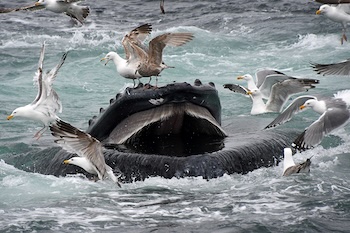It’s Time to Plan your Whale Watch
The 2025 season has started off strong, with humpbacks spotted on every single trip thus far! Our sightings list has already exceeded 50 individual whales, and we are adding new names to the list with each cruise. In addition to occasional sightings of finback and minke whales, we have also enjoyed multiple days with Atlantic white sided dolphins. What will you see when you sail with us?
Plan ahead! Purchase tickets now for your whale watch adventure.
Specialty Whale Watching Excursions

Calling all adventure-loving whale watchers! Our Extended Whale Watch is a 6-hour deep-sea experience crafted for those who crave more. With extra time on the water, we’ll explore beyond the usual routes—possibly venturing along Cape Cod’s stunning eastern coastline, including the wildlife-rich waters near Chatham. The whales will be our guide! Weather and sightings permitting, you’ll have the chance to spot elusive ocean wonders like seabirds, sea turtles, and even sharks!
This special voyage goes beyond whale watching! Our team of expert naturalists will be joined by field specialists who will share fascinating insights on seabirds, marine wildlife, maritime heritage, and local history. Plus, a professional photographer will be onboard, offering a hands-on Wildlife Photography Workshop—perfect for capturing jaw-dropping moments and improving your photography skills.
To keep you fueled, our full galley will be stocked with breakfast and lunch options, ensuring you stay energized for all the adventure. And for your comfort, we’re limiting capacity, so you’ll have plenty of space to soak in the views.
Ready for an unforgettable marine adventure? Book your spot on our Extended Whale Watch and make memories you’ll treasure forever!

Hey, families! Get ready for a whale-sized adventure designed just for kids (and their grown-ups)! Our Kids’ Day Whale Watch is a one-of-a-kind cruise where curious young explorers get front-row seats to the wonders of the ocean.
Our friendly naturalist will be your guide, sharing fun, kid-friendly stories about the amazing marine life you’ll see—no boring lectures here! With other excited kids on board and plenty of supervision, it’s a safe, exciting adventure for everyone.
Whether it’s the splash of a mighty whale, a host of dolphins, or a soaring seabird, your little ones will be mesmerized. Our crew will make sure this is an unforgettable experience for the whole family.
Ready for a family adventure that will make a splash? Book your spot now and get ready to create memories your kids will talk about for years!
Some whales may live nearly twice as long as believed—if we let them
From our friends at science.org:
Among mammals, whales are the longevity champs. Members of several species have lived past age 100, and one bowhead whale reached its 211th birthday. But estimates of whale longevity often require scarce tissue samples and can rely on techniques that are difficult to interpret.
A study published today in Science Advances may have found a better way. By combining decades long photo records with the same statistical approach companies use to set life insurance rates, scientists have deduced that at least one species of whale survives almost twice as long as researchers expected. Other whales may beat longevity predictions, too, the work suggests.
“What the authors have done here is quite impressive,” says marine mammal biologist C. Scott Baker of Oregon State University, who wasn’t connected to the study. “They make a good case for the plausibility of their results.”
For the full story, visit science.org here:
Don't Miss Out!
The latest news and events from the Hyannis Whale Watcher team.




